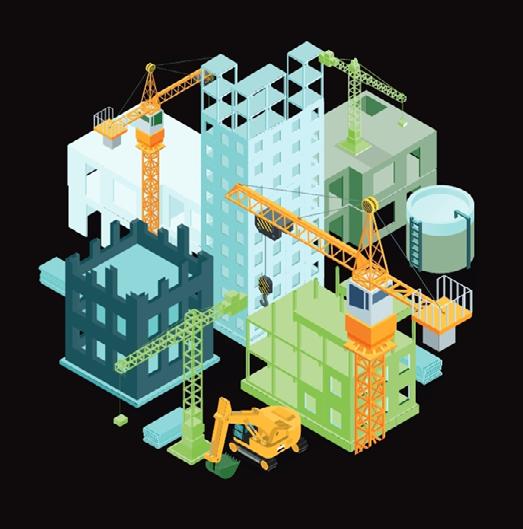
3 minute read
Tech needed to drive construction productivity
These challenges are already driving construction company insolvencies in Australia and technology is needed now more than ever to drive productivity in the industry, Autodesk says.
Its APAC Industry Strategist, Sumit Oberoi says the construction sector has unfortunately seen a number of collapses, with at least 20 construction companies in Australia folding in 2022.
Advertisement
“There are multiple factors involved such as a challenging procurement environment, labour and material shortages, extreme weather and supply chain disruptions.”
And yet, a total of $255 billion in Australian Government expenditure has been allocated to infrastructure over the four years between 2022-23 and 2025-26 – a three per cent increase over last year’s allocations. Additionally, in the October 2022-23 budget, the Australian Government announced an investment of almost $1.4 billion for vital land transport infrastructure projects in NSW alone to improve safety and reduce travel times.
“Government infrastructure and private commercial construction spend is increasing with the need to deliver more vital land, transport and housing projects across the country, and yet we’re seeing more construction companies under stress despite this increase in work,” says Oberoi.
“The industry is at a crossroad, and greater operational efficiencies are required to maintain competiveness. We have found that when a company adopts technology there is a direct positive impact on their revenue.”
This month, Autodesk announced the launch of its joint report with Deloitte, The State of Digital Adoption in Construction Report 2023, which surveyed 229 construction and engineering executives across Australia, Japan and Singapore’s architecture, engineering and construction (AEC) sector about how digital adoption affects them and what their outlook is in the face of such uncertain times.
Deloitte Access Economics Partner David Rumbens says the survey showed nearly nine in ten AEC businesses are investing in new technologies, and businesses with higher levels of digital adoption are more optimistic about the future and more likely to have international operations.
“Additionally, 61% of AEC businesses see using new technology to deliver projects as a key source of growth. Nearly two in five businesses are using Building Information Modelling (BIM) and cloud manage - ment software, while over a quarter of businesses are expecting to implement these technologies in the future.”
Oberoi says it is clear construction companies across Australia increasingly understand that to remain competitive in today’s marketplace, they need to innovate.
“However, some of the challenges to increasing technology adoption in the industry will require addressing, including upskilling staff, change management and budget allocation.”
Additional key findings included:
• 96% reported that previous digitisation efforts have boosted their business.
• For nearly half (45%) of businesses, the impact from digitisation efforts has already been high or very high
• Firms using more tech than average are 30% more likely to be optimistic about the future
• Just under two in three of (61%) businesses said using new technology to deliver client work would be a main source of revenue growth
• Nearly half said that growth would also come from using digital tech to improve internal processes
• Singaporean businesses are most concerned about high material costs and labour shortages
• Australian businesses are most concerned about uncertain economic conditions
• Japanese businesses are most worried about economic uncertainty and lack of skilled workers.
About Autodesk
Autodesk is changing how the world is designed and made. Our technology spans architecture, engineering, construction, product design, manufacturing, media and entertainment, empowering innovators everywhere to solve challenges big and small. From greener buildings to smarter products to more mesmerising blockbusters, Autodesk software helps our customers to design and make a better world for all. For more information visit autodesk.com or follow @autodesk.
In a new study, participants showed more empathy for an online anthropomorphic artificial intelligence (A.I.) agent when it seemed to disclose personal information about itself while chatting with participants. Takahiro Tsumura of The Graduate University for Advanced Studies, SOKENDAI in Tokyo, Japan, and Seiji Yamada of the National Institute of Informatics, also in Tokyo, present these findings in the open-access journal PLOS ONE on May 10, 2023.
The use of A.I. in daily life is increasing, raising interest in factors that might contribute to the level of trust and acceptance people feel towards A.I. agents. Prior research has suggested that people are more likely to accept artificial objects if the objects elicit empathy. For instance, people may empathize with cleaning robots, robots that mimic pets, and anthropomorphic chat tools that provide assistance on websites.
Earlier research has also highlighted the importance of disclosing personal information in building human relationships. Stemming from those findings, Tsumura and Yamada hypothesized that self-disclosure by an anthropomorphic A.I. agent might boost people’s empathy toward those agents.
To test this idea, the researchers conducted online experiments in which participants had a textbased chat with an online A.I. agent that was visually represented by either a human-like illustration or an illustration of an anthropomorphic robot. The chat involved a scenario in which the participant and agent were colleagues on a






